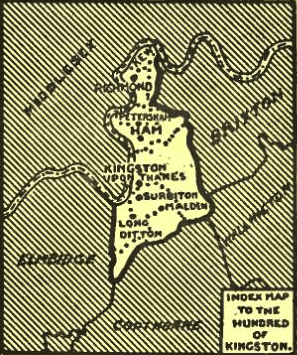Hundred of Kingston facts for kids
Quick facts for kids Kingston |
|
 |
|
| Geography | |
| Status | Hundred |
| 1871 area | 10,273 acres (41.57 km2) |
| History | |
| 1851 population | 18,194 |
| 1861 population | 22,997 |
The Hundred of Kingston was an old way to divide land in Surrey, England. Imagine it like a really old district or county. It was in the northeast part of Surrey.
Today, most of this area is part of London. Its name now refers to the town of Kingston upon Thames. It also refers to the larger Royal Borough of Kingston upon Thames. The old area of the Hundred now covers this borough. It also includes parts of the London Borough of Richmond upon Thames. A small part is in the Borough of Elmbridge in Surrey.
The Hundred of Kingston was surrounded by other "hundreds." To the east was the Hundred of Brixton. To the south was the Hundred of Elmbridge. The River Thames formed its western and northern borders.
Contents
What Parishes Were in Kingston Hundred?
A "parish" was like a local community or village. The Hundred of Kingston included several parishes over time:
- Chessington (until 1610)
- Esher (part of it)
- Ham with Hatch (created in 1866 from part of Kingston upon Thames)
- Hook (created in 1866 from part of Kingston upon Thames)
- Kew
- Kingston upon Thames
- Long Ditton
- Malden
- Petersham
- Richmond
- Thames Ditton (part, from 1769)
Kingston Hundred in the Domesday Book
The Domesday Book was a huge survey. It was ordered by William the Conqueror in 1085. It listed all the land and property in England.
In this famous book, the Hundred of Kingston was recorded. It included Kingston, Petersham, Long Ditton, Thames Ditton, and Malden.
How Big Was the Hundred of Kingston?
In 1871, the Hundred of Kingston was described as having six full parishes. It also had part of another parish.
The area was divided into two main parts. The first part was about 6,655 acres (26.93 km²). The second part was 3,618 acres (14.64 km²).
How Many People Lived There?
The population of the Hundred of Kingston changed over time. In 1851, the first division had 15,773 people. The second division had 2,421 people.
Just ten years later, in 1861, the total population grew. It reached 22,997 people. This was an increase of over 2,000 people!

